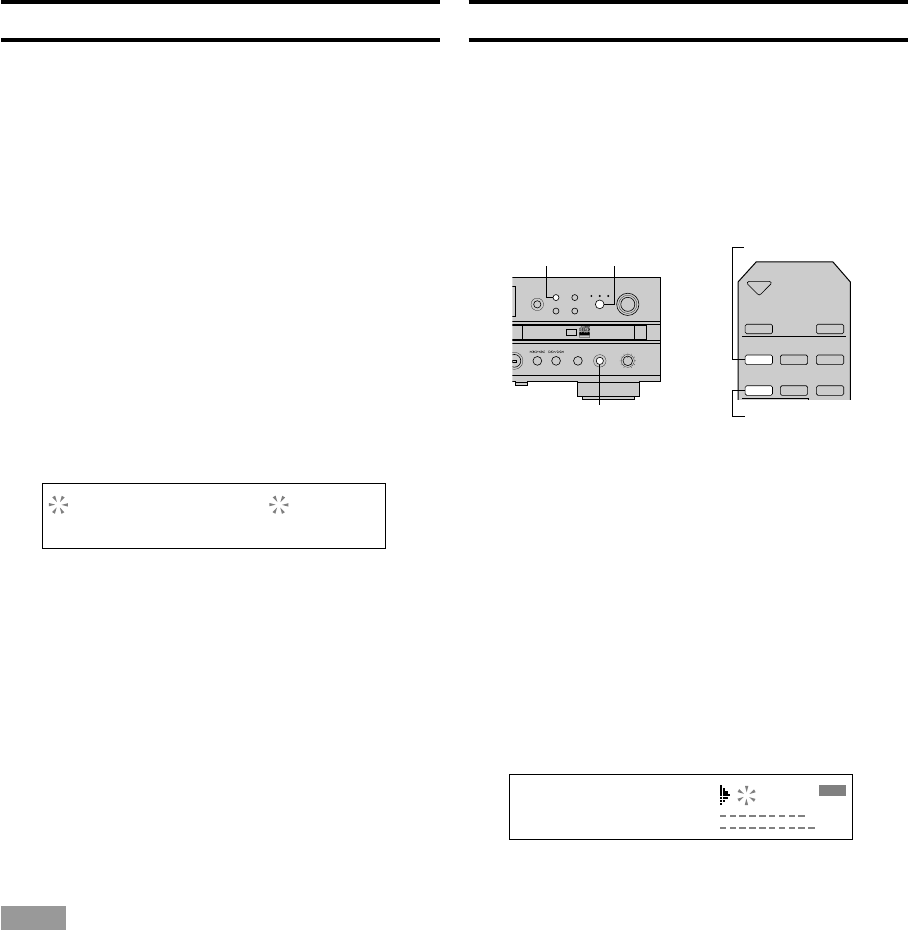
E-16
RECORDING FUNCTIONS .....................................................
CD DIRECT Copy
This unit has a CD DIRECT copy function using both disc
trays. It digitally copies an entire source CD placed on disc
tray A onto a disc placed on disc tray B to be used for
copying.
When making a CD DIRECT copy, the copy speed can be
selected at either normal or double speed. However the
recording level cannot be changed when making a CD
DIRECT copy.
1.
Load a source CD on disc tray A and a disc to be
used for copying on disc tray B. Press v (OPEN/
CLOSE on the remote) to close the trays.
Make sure that the recordable time on the disc to be
used for recording is longer than the total play time on
the source CD.
2.
Press and rotate the MULTI JOG knob on the
front panel (MENU and +/– on the remote) to
select “Copy Speed” in the set menu shown in the
display. Then press the MULTI JOG knob (MENU
on the remote) again.
3.
Copy speeds of “x1” and “x2” appear blinking
alternately in the display as the MULTI JOG knob
(+/– on the remote) is rotated. Select the desired
copy speed by pressing the knob (+/– on the
remote).
4.
After the copy speed is set, press COPY to start a
CD DIRECT copy.
When making a CD DIRECT copy with the
synchronized recording mode described in the
next section, press REC MODE to select the
synchronized recording mode and press COPY.
When copying is complete, finalization automatically
starts and the disc can then be played on a standard
CD player. However, finalization is not performed when
doing single or all track synchronized recording.
Notes
• While making a CD DIRECT copy at double speed, the analog
signal can be heard but the digital signal can not.
• Never turn off the power or pull out the plug out from the wall
outlet during a CD DIRECT copy.
• A disc copied from a source CD cannot be copied to another
disc.
See page 28 for Serial Copy Management System (SCMS)
standards.
• If a disc cannot be digitally copied, analog copy is possible. To
make an analog copy, set the “SCMS Mode” to “ANALOG“ in the
menu settings. (See page 11 for details.)
Synchronized Recording
This function automatically starts recording when an audio
signal is detected. Therefore, recording starts at the same
time the source CD starts playback. There are three ways of
doing synchronized recording as follows:
■ Single track synchronized recording
This mode is convenient for recording a mix of tracks from
different sources. A new track marker is automatically
placed at the start of each track.
1.
Load a disc to be used for recording.
Use a disc containing enough space for recording a
source CD.
2.
Press REC to set this unit to the record pause
mode.
3.
Select the appropriate input source to be used for
recording by using INPUT on the front panel.
4.
Adjust the recording level. (See page 15.)
5.
Make sure that the source component is in the
stop mode.
6.
Press REC MODE.
The SINGLE and SYNCHRO indicators light in the
display.
7.
Start playing the source.
• This unit automatically starts recording.
• When playback of the current track is over (digital
recording), or this unit has recorded 4 seconds of
continuous silence as a track separation (analog
recording), recording ends. Then this unit enters the
record pause mode and synchronized recording
mode is canceled.
8.
Repeat steps
5
,
6
and
7
to record another
track.
9.
Press a when all recording is complete.
Disc information is being written to the PMA (Program
Memory Area).
When all recording is complete, perform finalization. (See
page 21 for the finalization procedure.)
Copy x2
CD–R
L
dB
R
–60 –30 –I0 –6 –4 –2 –I0
OVER
DISC B
Recordable
ReWritable
COPY
REC MODE TRACK NO.
FINALIZE ERASE
INPUT
MULTI JOG
DIGITAL REC LEVEL
DISC A DIGITAL ANALOG
PUSH MODE
ANALOG REC LEVEL
MINFADE IN
/
OUT MAX
REC MUTE
REC
REC MODE INPUT
REC
COPY
A
FADE IN
/
OUT
REC
REC MUTE
TRACK NO.
WRITE
REC MODE
FINALIZE ERASE
OPEN
/
CLOSE
B
REC
REC MODE
2 1:41
CD–R
44.I
REC
SINGLE
SYNCHRO
L
dB
R
–60 –30 –I0 –6 –4 –2 –I0
OVER


















